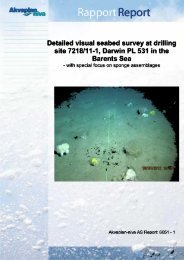A study of the priority substances of the Water Framework Directive ...
A study of the priority substances of the Water Framework Directive ...
A study of the priority substances of the Water Framework Directive ...
You also want an ePaper? Increase the reach of your titles
YUMPU automatically turns print PDFs into web optimized ePapers that Google loves.
..:::::::::: lindane<br />
..:::46<br />
18b Lindane<br />
� Lindane is <strong>the</strong> gamma isomer <strong>of</strong><br />
Hexachlorocyclohexane (HCH).<br />
� Lindane is a broad-spectrum insecticide. It<br />
has been used since 1949. Approximately 80%<br />
<strong>of</strong> <strong>the</strong> total production is used in agriculture.<br />
� Lindane was used in Norway until 1992.<br />
� There is a need for fur<strong>the</strong>r monitoring <strong>of</strong><br />
Lindane, both in Hardangerfjorden in<br />
Hordaland County and in Nordre Åklangen in<br />
Eidskog in Hedmark County.<br />
Production and use<br />
Internationally, Lindane has been used for seed<br />
and soil treatment and for timber and wood<br />
treatment. It was banned in Japan from 1971<br />
and in EU from 2000. Globally, it's still in use.<br />
The substance was used in forestry and agriculture<br />
in Norway until 1992, when it was banned.<br />
It was also used in houses against old house<br />
borer (Hylotrupes bajulus) and as scabies treatment<br />
on humans. 50 000 kg Cyclodiene<br />
organochlorines were sold between 1974 and<br />
1978 (probably less than 50 % was Lindane).<br />
47 000 kg Lindane were sold between 1979 and<br />
1992. There are no entries <strong>of</strong> Lindane in <strong>the</strong><br />
Norwegian Product Register since 1995.<br />
Emissions, discharges,<br />
distribution and hot-spots<br />
Lindane emission has mainly been from agricultural<br />
use and from forestry. As Lindane has<br />
been used on humans and in private homes,<br />
summer houses etc. it is reasonable to expect<br />
that Lindane is still being stored privately.<br />
Lindane may also leak from landfills, and it is a<br />
transboundary air pollutant.<br />
Monitoring<br />
Monitoring <strong>of</strong> Lindane has been studied in several<br />
investigations. It is also a part <strong>of</strong> RID,<br />
where time trends exist, but <strong>the</strong>se are highly<br />
inaccurate.<br />
Marine sediments<br />
In marine sediments Lindane has been investigated<br />
at 25 localities along <strong>the</strong> coast. The levels<br />
are relatively low except in Tyssedal in<br />
Sørfjorden and in <strong>the</strong> inner parts <strong>of</strong><br />
Sandefjordsfjorden.<br />
A <strong>study</strong> <strong>of</strong> <strong>the</strong> <strong>priority</strong> <strong>substances</strong> <strong>of</strong> <strong>the</strong> <strong>Water</strong> <strong>Framework</strong> <strong>Directive</strong><br />
TA-2140/2005<br />
FACTS<br />
Cas no.: 58-89-9<br />
Synonyms: Lindan, BHC, Agrocide, Ambrocide,<br />
Aparasin, Aphitiria, Benesan, Benexane, benhexachlor,<br />
benzene hexachloride, BoreKil, Borer-Tox,<br />
Exagama, Gallogama, Gamaphex, gamma-BHC,<br />
Gamma-Col, gamma-HCH, Gammex, Gammexane,<br />
Gamasan, Gexane, Isotox, Jacutin, Kwell, Lindafor,<br />
Lindagronox, Lindaterra, Lindatox, Lintox, Lorexane,<br />
New Kotol, Noviagam, Quellada, Steward, Streunex,<br />
gamma HCH.<br />
Properties: White to yellow crystalline powder<br />
Toxic effects: Lindane is toxic. Oral LD50 88 - 190<br />
mg/kg in rats. Lindane is an irritant, possibly carcinogen<br />
and on <strong>the</strong> EU list <strong>of</strong> endocrine disruptors. The<br />
substance is highly to very highly toxic to fish and<br />
aquatic invertebrate species. Reported 96-hour LC50<br />
values range from 1,7 to 90 µg/l in trout (Salmo<br />
trutta). It is also highly toxic to bees.<br />
Log Kow: 3,9<br />
Persistence: Half-life is 15 months in soil with 75% - 100<br />
% disappearance 3-10 years (HSDB). Lindane is persistent<br />
in salt and fresh water (EXTOXNET), half-life in<br />
water is 42 - 400 days (evaporation and bacterial<br />
degradation). (HSDB)<br />
DT50 water = 12 days - > 30 days (20°C)<br />
DT50 sediment = 135 days - 162 days (20°C)<br />
DT50 whole system = 91 d - 697 d (CIRCA)<br />
<strong>Water</strong> solubility: 7,8 - 8,5 mg/l<br />
Molecular formula: C 6 -H 6 -Cl 6<br />
Metabolites: 2,4,6-, 2,3,5- and 2,4,5-trichlorophenol<br />
(human). Gamma-2,3,4,5,6-pentachloro-1-cyclohexene,<br />
gamma-3,4,5,6-tetrachloro-1-cyclohexene,<br />
beta-3,4,5,6-tetrachloro-1-cyclohexene, pentachlorobenzene,<br />
1,2,4,5-tetrachlorobenzene, and<br />
1,2,3,5-tetrachlorobenzene (bacteria).<br />
Fresh water<br />
Ten large rivers have been investigated for<br />
Lindane since 1990. In addition more than one<br />
hundred small rivers have been investigated<br />
once a year since 1990. The levels are relatively<br />
low. Several streams are also investigated, and in<br />
Timebekken in Rogaland County elevated levels<br />
were found.

















